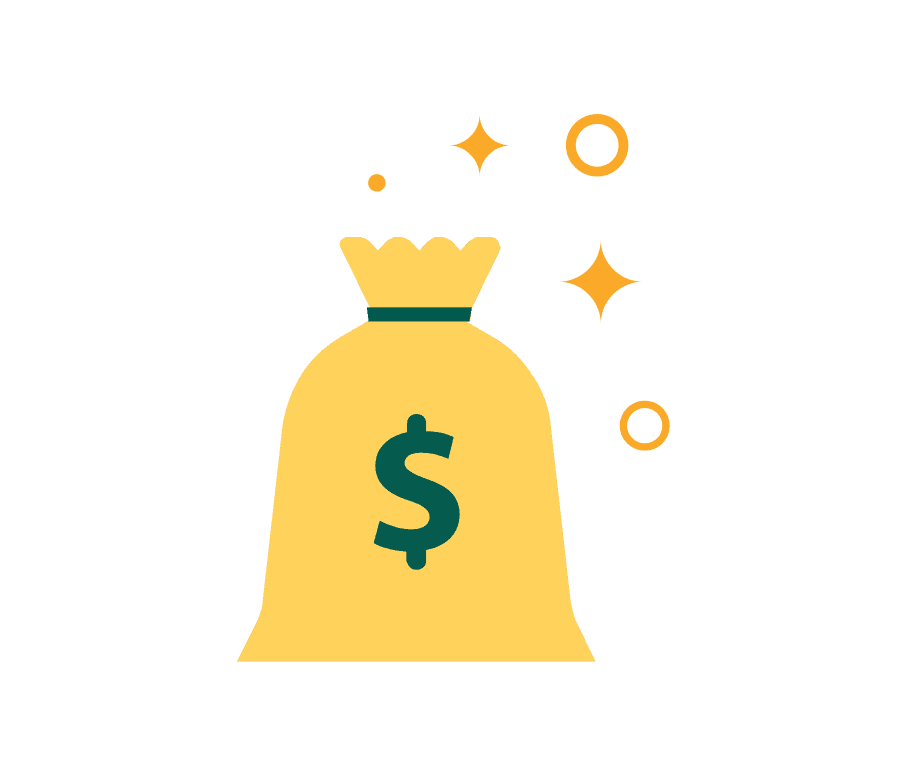To get a $10,000 loan, start by researching the options available to you. This means looking for lenders you're likely to qualify with and prequalifying to get a sense of the interest rates you could be approved for. A low-interest personal loan can help with emergency expenses, debt consolidation, or big purchases. But the best personal loan will have a monthly payment you can comfortably afford and improve your financial situation and quality of life.
Compare personal loan rates
Online lenders, banks, and credit unions offer personal loans with annual percentage rates (APRs), loan limits, and qualification requirements that vary by lender. On average, personal loan rates are much lower than credit card rates — at 12.49% (for a two-year loan) compared 21.59% for credit cards, according to the Federal Reserve.
Credible rating
Fixed (APR)
6.99% - 25.49%
Loan Amounts
$5000 to $100000
Min. Credit Score
700
Credible rating
Fixed (APR)
7.80% - 35.99%
Loan Amounts
$1000 to $50000
Min. Credit Score
620
Credible rating
Fixed (APR)
-
Loan Amounts
$2500 to $40000
Min. Credit Score
660
Credible rating
Fixed (APR)
8.49% - 35.99%
Loan Amounts
$1000 to $50000
Min. Credit Score
600
Credible rating
Fixed (APR)
8.98% - 35.99%
Loan Amounts
$1000 to $40000
Min. Credit Score
660
Credible rating
Fixed (APR)
8.99% - 29.99%1
Loan Amounts
$5000 to $100000
Min. Credit Score
Does not disclose
Credible rating
Fixed (APR)
8.99% - 35.99%
Loan Amounts
$2000 to $50000
Min. Credit Score
600
Credible rating
Fixed (APR)
9.95% - 35.99%
Loan Amounts
$2000 to $35000
Min. Credit Score
550
Credible rating
Fixed (APR)
-
Loan Amounts
$5000 to $35000
Min. Credit Score
700
Credible rating
Fixed (APR)
11.69% - 35.99%
Loan Amounts
$1000 to $50000
Min. Credit Score
560
Credible rating
Fixed (APR)
11.72% - 17.99%
Loan Amounts
$3000 to $40000
Min. Credit Score
640
Credible rating
Fixed (APR)
-
Loan Amounts
$20000 to $200000
Min. Credit Score
660
Credible rating
Fixed (APR)
14.30% - 35.99%
Loan Amounts
$3500 to $40000
Min. Credit Score
640
Credible rating
Fixed (APR)
18.00% - 35.99%
Loan Amounts
$1500 to $20000
Min. Credit Score
540
All APRs reflect autopay and loyalty discounts where available | LightStream disclosure | SoFi Disclosures | Read more about Rates and Terms
Where to get a $10,000 personal loan
Online lenders
Most online lenders offer $10,000 loans, and some offer loans up to $100,000 or more. Funds are typically available within a day of loan approval, and some lenders can send money the same day you apply (find out when that lender's cutoff time is for same-day funding).
If you're looking for a fair-credit personal loan, you have options. But remember that interest rates for borrowers with better credit can be significantly lower than those with bad credit. Check the lender's minimum credit score requirement to see if you are eligible.
But because some have flexible credit requirements, you might have better luck getting approved by online lenders, especially if you've been turned down by traditional lending institutions. To find out, prequalify with several lenders to quickly see potential rates and terms.
You can compare prequalified rates from multiple Credible partners by filling out one form (instead of a form for each on their sites). Prequalifying won't hurt your credit, but it's not an offer of credit, and your final rate may differ. Formally applying for a loan will also trigger a hard credit inquiry that could temporarily ding your credit score.
Banks and credit unions
Banks and credit unions often offer personal loans, along with checking, savings, and other secured and unsecured loans. They may also offer funds through a line of credit, which is a revolving form of credit, like a credit card.
Loan limits vary from institution to institution, but credit unions may be more willing to accommodate you than banks. However, some banks offer relatively large loan amounts. Wells Fargo, for example, offers $100,000 loans to qualified applicants. Prepayment penalties are rare, but origination fees may be charged.
The interest rates are usually fixed and can be some of the lowest available if you have excellent credit and a strong income. Another plus is that your personal bank might offer loyalty or relationship discounts if you already have an account with them.
A good rule of thumb — if you're seeking to minimize the long-term cost — is to select a loan with the biggest monthly payment and the shortest repayment term (as well as the lowest APR) you can afford. By doing so, you’ll pay less interest over the life of the loan, thereby reducing your overall costs.
Learn More: Low-Income Personal Loans: How and Where To Get One
Personal loan requirements
Lenders require certain information and documents to verify your identity, income, and ability to repay the loan. In general, this is what you can expect to provide:
- Basic identifying information: Most applications will require that you provide your full name, date of birth, and Social Security number.
- Employer and income verification: Lenders want to be sure of your ability to pay back the loan in full. One way they determine this is to verify your income and employer information. Providing pay stubs and W-2s are common ways that lenders verify employment. However, if you are self-employed, other documents may be required, such as banking statements and/or 1099s.
- Minimum credit score: Some lenders require a minimum credit score to approve your personal loan application, while others are more flexible.
- Debt-to-income ratio (DTI): In general, it’s good to keep your debt-to-income ratio below 36%. If your DTI is higher than that, consider paying off your debts before applying for a personal loan.
Learn More: Personal Loan Requirements: What To Know
What to consider when comparing loans
If you're considering multiple $10,000 personal loan options, here's what you should research before making a decision:
- APR
- Fees
- Repayment term
- Monthly payment and total cost
1. APR
The annual percentage rate (APR) is the main thing to consider when borrowing money. This is how much it will cost to borrow money, and accounts for the interest rate as well as upfront fees (if there are any). Typically, the shorter the loan term, the lower the APR offered by most lenders.
You should also decide if a fixed- or variable-rate loan is best for your situation. Most personal loan lenders offer fixed-rate loans.
Learn More: APR vs. Interest Rate on a Personal Loan
2. Fees
The next thing to look out for is fees. Origination fees, for one, are taken out of your loan proceeds before you even see them (these are reflected in the APR), which means you could get less than you applied for from a lender that charges an origination fee. Also consider late fees and insufficient funds fees.
3. Repayment term
Your repayment term is the amount of time you have to pay back the money you've borrowed. The cost to repay the loan depends not only on the loan amount you borrow and at what interest rate, but on how long you take to repay your loan.
Keep in mind
The longer your repayment term, the more interest you'll pay over the life of your loan; the shorter your repayment term, the lower the interest rate offered by most lenders.
4. Monthly payment and total cost
Another consideration should be your monthly payment. You should make sure a personal loan will fit into your budget. If it seems that the monthly payment will eat up too much of your paycheck, you can look at loans with longer repayment terms.
If you stretch your payments out over seven years instead of five, you'll make 84 payments instead of 60, so each payment will be smaller. Just remember that the longer the repayment term, the higher the interest rate and total repayment costs will be.
Getting a $10,000 loan with bad credit
Having bad credit does not automatically disqualify you from getting a $10,000 personal loan.
However, borrowers with poor credit can often expect higher APRs. A cosigner with good credit or securing the loan with collateral can help you get approved with more favorable rates.
Here’s what you need to do to apply for a $10,000 personal loan with bad credit:
- Check your credit score: Check your FICO credit score so you can be realistic about your loan options. Eliminate any lenders that have a minimum credit score requirement higher than yours. (Check out lender minimums in the table above, though some lenders have different minimums on their website than they accept through marketplaces.)
- Consider a cosigner: If your credit score is poor, a cosigner with a good score can help you get approved for a loan. Just note that only a handful of lenders offer personal loans with a cosigner, including OneMain Financial, BHG Financial, PenFed, Navy Federal, and Achieve. Also, note that the cosigner is equally responsible for loan repayment — even late payments could hurt their credit (and yours).
- Consider a secured loan: Some lenders let you secure a personal loan with collateral like your car or the fixtures in your home. Going this route could help you get approved or lower your rate. Two lenders that offer secured loans include OneMain Financial and Upgrade. Just know that if you can’t repay the loan, the lender can seize your collateral.
- Get prequalified: Getting prequalified with multiple lenders for bad credit can help you compare rates without a hard credit check. Just note that once you formally apply for a loan, you will undergo a hard inquiry, which can drop your score by a few points for up to a year.
- Choose a lender and apply: Choose a lender that is right for your situation with favorable terms and apply.
Getting a $10,000 loan with no credit
It may be possible to get a $10,000 personal loan with no credit. But like loans for bad credit, lenders often charge higher fees and interest rates for no-credit loans as well, and that’s if you can qualify. But a cosigner with good credit can help you get approved and even lower your rate.
If you don’t need the loan immediately, you could establish credit first by getting a credit-builder loan, or by becoming an authorized user on a good friend’s or family member’s credit card.
Cost to repay a $10k loan
It is important to consider the long-term costs of a loan before taking one out. The table below shows the relationship between your repayment term, interest rate, monthly payment, and total interest charges. The interest rates in the table are hypothetical and for illustration purposes only.
A good rule of thumb — if you're seeking to minimize the long-term cost — is to select a loan with the biggest monthly payment and the shortest repayment term (as well as the lowest APR) you can afford. By doing so, you’ll pay less interest over the life of the loan, thereby reducing your overall costs.
Personal Loan Calculator
If you decide to take out a personal loan, use a personal loan calculator to determine interest charges over time.
Read More:
- Adoption Loans
- Boat Loans
- Business Loans
- Deck Financing
- Engagement Ring Financing
- Funeral Loans
- Gym Equipment Financing
- Home Improvement Loans
- HVAC Financing
- IVF Loans
- Kitchen Remodel Loans
- Medical Emergency Loans
- Landscaping Financing
- Loans for Students
- Loans to Buy Land
- Medical Emergency Loans
- Plastic Surgery Financing
- Pool Loans
- Roof Financing
- RV Loans
- Self-Employed Loans
- Solar Financing
- Startup Business Loans
- Unemployment Loan


